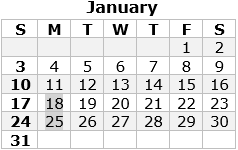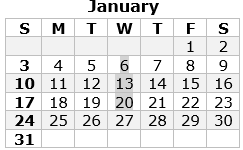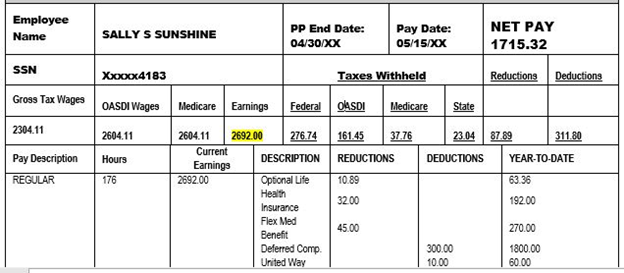Income
Application Month Income
Income Starts in Application Month
Application received 1/25. Applicant verifies new employment starting 1/13 with wages received 1/18 and 1/25. Budget the 1/18 and 1/25 wage for January. For February, budget the average weekly wage times 4.3.

Income Stops in Application Month
Application received 1/15. The applicant was paid weekly. The final wage will be received on 1/20. The applicant has not found a new job, and will have zero wages for February. For January budget only the actual wages for 1/6, 1/13 and 1/20. Budget zero income for February unless the EDG reports a change.

Income Date and Receipt Unknown in Application Month
Application received 4/14. Applicant lost their job on 4/1 with their last check received 4/4. They state they were told they were eligible for unemployment compensation benefits (UCB) but the amount and date of receipt is unknown. Budget the 4/4 wage as the only income. The UCB income is not budgeted because the receipt date and amount are unknown. Remove the wage amount for May benefits.
Income Received Less Often Than Monthly
Application received 11/15. Applicant verified quarterly retirement payments of $2200, received the first of January, April, July, and October. Budget $733.33 for November ($2200/3) and the following months. Budget income over the period it is intended to cover for the application month, even if it is not received in the application month.
Income for the Month Intended
Income is paid on the first of the month except when the first falls on a weekend or holiday, then it is received on the previous workday. Count the income as received on the first day of the month it is intended.
Contractual Income
Annual Income
A member of the EDG is a teacher. The contract for teaching covers a full year from August through the following July and pays $18,000. The teacher actually works August through May. The income from teaching is intended to support the family for the year. Budget $1500 ($18,000/12) for each month.
Not Intended as Annual Income
A member of the EDG works during the summer as a lifeguard. The contract covers the period of May through August and pays $2000 for the 4-month period. The income is not intended as the EDG’s annual income. Budget $500 ($2000/4) for the months of May, June, July and August. Remove the income for September.
Fluctuating Income
Income Fluctuates in Application Month
Application received 1/20. The only income is weekly wages which fluctuate because of ongoing shift changes. Budget actual wages for 12/28, 1/4, 1/11 and 1/18 unless the amount is not representative of future income. If not representative, average the number of pays necessary to obtain representative monthly income. (This may require more than 30 days.)
Convert to a monthly amount:
- Add total wages used
- Divide by the number of pays used
- Multiply by 4.3

Periodic Report
Periodic report received 8/28. Recipient started working on 6/1 and is paid weekly on Thursday. The amount of hours they work depends on how busy they are at work. Budget:
- the last 30 days pays if representative of normal income, or
- use a longer period if needed to arrive at a representative income amount.
Whichever method is used to determine the representative amount, convert to a monthly amount:
- Total all wages
- Divide by the number of pays used
- Multiply by 4.3 to arrive at an average monthly income.
Interim Change
On 5/16 the recipient reports starting work on 3/22 and is paid biweekly. Obtain wage amounts for the 30 days prior to 5/16. Budget 4/28 and 5/12 wages, if representative of normal income, or an average of the 4/14, 4/28 and 5/12 wages if a longer period is needed. The 3/31 wage is not used because it is a partial pay. Convert to monthly amount:
- Add total wages used
- Divide by the number of pays used
- Multiply by 2.15
Intermittent Income
Renewal application received 3/2. Recipient works as a substitute teacher and works when called. Substitutes are paid on Mondays when they work the prior week. For January and February, the recipient was paid 1/18; 2/1 and 2/29. No wages were received 1/4, 1/11, 1/25, 2/8, 2/15, or 2/22.
To determine the representative income:
- Total the wages received
- Divide by 9 pay periods (including the weeks they did not get paid)
- Multiply by 4.3

Renewal Application
Renewal application received 2/12. Recipient verified wages for the last 30 days and stated the 1/25 wage was lower because they called in sick one day and weren’t paid for that day. They don’t anticipate missing days in the future. Budget the average of the 1/18, 2/1 and 2/8 wages if they are representative. Convert to a monthly amount:
- Total the 3 wages
- Divide by 3
- Multiply by 4.3

Wage Stub Review
Calculating Missing Paystubs Using YTD
Households must provide a full four weeks or a month’s worth of consecutive paystubs.
If a member of the household submits a series of paystubs that is missing pay coverage for two weeks or less, workers may use the year to date (YTD) calculation to yield the amount for the missing wages:
Missing Wages = Most Recent YTD - Most Recent Wages - Previous YTD
Example on how to calculate missing pay stub using YTD:
|
Pay Date |
Gross Income |
YTD Income |
|
6/6 |
$287.15 |
$5,432.98 |
|
6/13 |
$312.15 |
$5,745.13 |
|
6/20 |
? |
? |
|
6/27 |
$275.00 |
$6,330.63 |
A check is missing from pay date 6/20 period. Since we have the pay stub information from the week before as well as the pay stub information from the week after, we can calculate for the missing information.
First, take the most current YTD and subtract that same check’s gross income. ($6,330.63 - $275)
That sum now becomes your revised YTD income for the missing pay stub. From that, you must subtract the previous YTD income that you have from the prior check. ($6,055.63 - $5745.13)
When you do that math, you will determine the gross weekly amount of the missing check. ($310.50)
Pre-Tax Gross Wage
Use gross income before any deductions in the income determination calculation. The following wage stub shows differing gross wage amounts. Budget the gross wage amount prior to any pre-tax deductions. $2692 is budgeted.

More than One Gross Income Amount
Occasionally wage stubs do not show the total gross income. Review wage stubs carefully to determine the correct gross wage. For this wage stub, regular wages, shift differentials and overtime have to be added together to determine gross wages. Budget $402.08 gross income if the extras are expected to continue. Do not include additional wages not expected to continue.

Last Update
Source #: 12
Effective Date: 06/01/2023